How to See The Best of South Africa in 12 Days
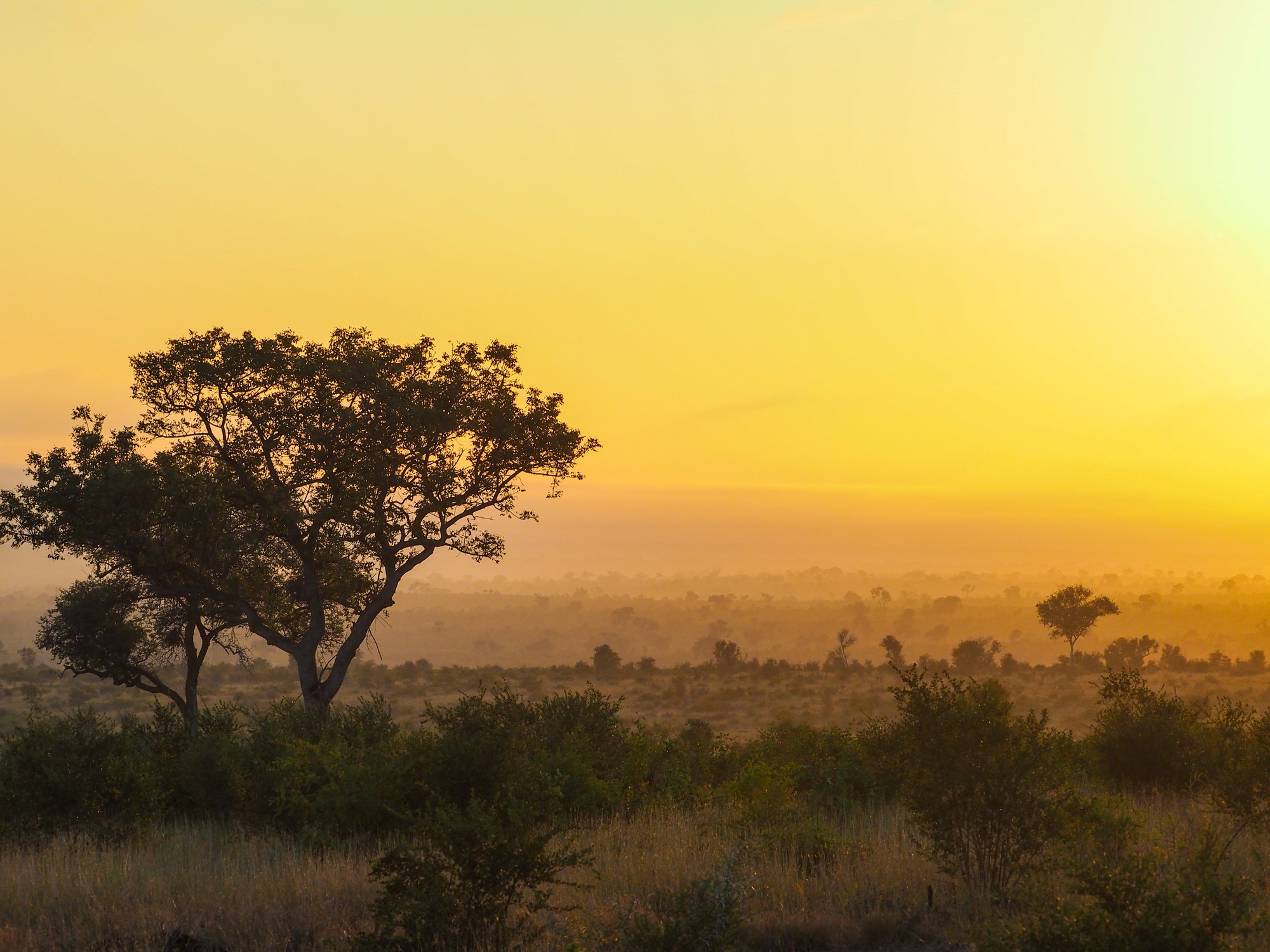
In the past few years, South Africa has raced to the top of many travelers' must-visit lists. Filled with stunning vistas, cool cities, and all that famous African wildlife, the country really does have it all.
Add to this a strong US dollar and weaker South African rand, and it's never been a better time to travel to South Africa.
If you're considering a trip to South Africa this year, here's a 12-day itinerary that will help you experience the best of what this great country has to offer. From Cape Town to Kruger National Park, you'll get the perfect introduction to South Africa even if you don't have a ton of vacation time.
Travel Itinerary: The Best of South Africa in 12 Days
Day 1: Arrival and Gansbaai
Most people would probably have you start your South African adventure in one of the country's major cities like Johannesburg or Cape Town. But I'm actually going to suggest that you fly into Cape Town and then head to the little coastal town of Gansbaai in the Western Cape.

Gansbaai is most famous for being close to Dyer Island, where lots of great white sharks can be found. But the real reason I'm suggesting you start out here is because the town is both beautiful and super laid-back, making it an excellent introduction to South Africa.
Spend your first half-day strolling around the town and catching a beach-side sunset.
Where to stay in Gansbaai: My pick is The Roundhouse, a locally-owned guesthouse that's very unique. It has a hot tub on the top deck with views out over the town and ocean, and the breakfasts can't be beat. (Plus, they can transfer you from/to Cape Town, and arrange any activities you might want to do in Gansbaai.) (Read reviews | Book here!)
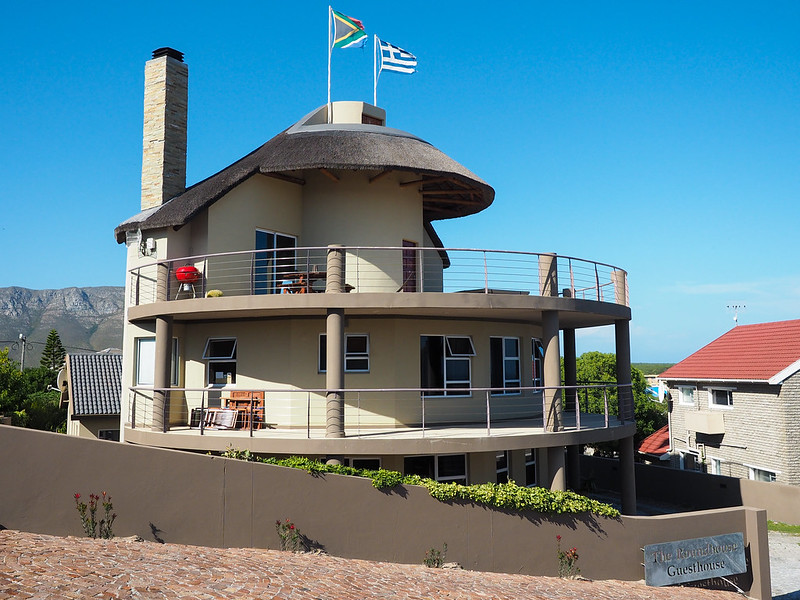
Where to eat in Gansbaai: Speaking of meals, definitely have one at Blue Goose, which serves up fresh local seafood and some of the tastiest South African beef.
Day 2: Shark cage diving or dune biking
One of the biggest draws of Gansbaai is, of course, the great white shark diving trips. I recommend going with Marine Dynamics because of their pledge to marine conservation, but most companies in Gansbaai (of which there are many!) offer very similar experiences.
RELATED: Should You Go Cage Diving With Great White Sharks?
If shark cage diving doesn't appeal to you, you might want to get your adventure on by hitting the sand dunes on a fatbike instead. Roundhouse owner Dave Caravias also runs Fatbike Tours, which offers up a few different tour options in the Gansbaai/Hermanus region.
Whichever adventure you choose, you'll be back in Gansbaai by late afternoon. Decompress in the Roundhouse's hot tub, and enjoy another South African sunset.

Where to stay in Gansbaai: At The Roundhouse again, of course!
Day 3: Southern tip of Africa
Many people incorrectly think that the Cape of Good Hope near Cape Town is the southernmost point of Africa. But this actually isn't true! The real southernmost point is at Cape Agulhas, about an hour and a half from Gansbaai. Visit the lighthouse here, as well as the point where the Indian and Pacific oceans meet.
We stopped for lunch at the Pelican's Harbour Cafe in nearby Struisbaai, where I had the best (and cheapest!) seafood platter of my life.

If you're up for more sightseeing (and a little extra driving) in the afternoon, consider heading north of Gansbaai to the Walker Bay wine region. I loved the tasting room at Creation Wines, located on the Hemel-en-Aarde Ridge.
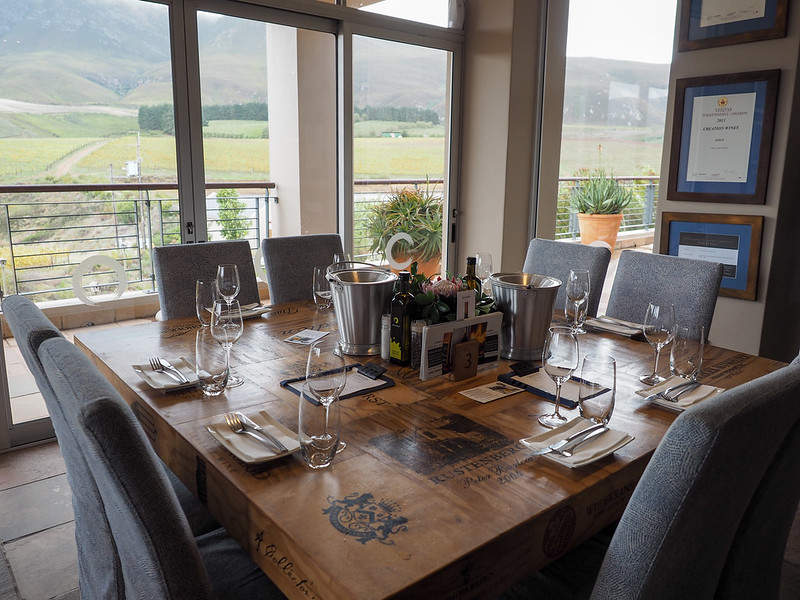
*Note: Great white shark cage diving is highly weather-dependent, which is why it's ideal to stay in town at least a couple of days in case your original tour gets canceled. You can easily swap Days 2 and 3 if the weather isn't cooperative. (And, if for some reason you don't have enough time to spend multiple nights in Gansbaai, you *can* book a cage diving tour from Cape Town.)
Day 4: To Cape Town!
Now that you've settled into the South African pace of life, it's time to head to the Mother City: Cape Town.
It's about a 2-hour drive from Gansbaai to Cape Town, so you'll want to start off early in order to make the most of your first day in the city.
Start your Cape Town explorations at the V&A Waterfront, home to South Africa's oldest working harbor, a huge shopping mall, a Ferris wheel, and a large collection of shops and restaurants, all within view of Table Mountain.
One of my favorite parts of the waterfront is the Watershed, which is essentially a large converted warehouse that now houses more than 150 vendors selling everything from original art to vintage clothing.

The V&A Waterfront is also where you'll find the ferries that will take you out to Robben Island, which is home to the prison where Nelson Mandela spent 18 of his 27 years of political imprisonment. Ferries depart every 1-2 hours from Nelson Mandela Gateway at the V&A Waterfront, and tours of Robben Island are conducted by former political prisoners.
Whether you decide to spend your afternoon in the city or touring Robben Island, I suggest ending the day watching the sun set at Camps Bay, one of the more affluent areas of Cape Town. The beach at Camps Bay is nice, but at sunset the dying light paints the looming Twelve Apostles mountain range opposite the bay an otherworldly orange. It's absolutely beautiful and is a great way to end your first day in the city.

Where to stay in Cape Town: I stayed at three different hotels in Cape Town:
The Commodore Hotel – This upscale hotel is comfortable, has a great breakfast, and is just around the corner from the V&A Waterfront. (Read reviews | Book here!)
The Taj – The Taj is a 5-star hotel in the heart of downtown Cape Town. Normally I would never stay in a hotel this nice, but right now it's actually not exorbitantly priced. My dad and I were upgraded to a huge 2-room suite here, which was bigger (and way nicer) than my apartment at home. (Read reviews | Book here!)
The One 8 Hotel – If you're interested in a more affordable hotel in a different neighborhood, I can recommend the One 8 Hotel in Green Point. The staff was super nice, and it was just a short walk to a really nice waterfront path. (Read reviews | Book here!)
Or, you can compare Cape Town hotel prices here to find even more options.
Where to eat in Cape Town: There are TONS of great restaurants in Cape Town to choose from. If you're looking for something quick and nearby, though, V&A Food Market is a great place to find delicious street-food-type fare.
Day 5: Cape Town
Start your morning off with a unique way of seeing Cape Town. My votes are either a helicopter tour, or a ride in the sidecar of a WWII-era motorcycle.
Helicopter tours of Cape Town aren't a cheap outing (think at least $100-$150 per person), but it's one of the best ways to see Cape Town. Even on a cloudy day, the views over the city are nothing short of stunning.

Or, if heights and flying aren't really your thing, check out the city tours offered by Cape Sidecar Adventures. I did a short tour with them from Signal Hill to Hout Bay, which ended up being one of the coolest city tours I think I've ever taken!
They offer a 2-hour tour that makes for a perfect (and totally unique) introduction to Cape Town.

Next, no trip to Cape Town would be complete without a visit to Table Mountain, which is the large, flat mountain that overlooks all of the Mother City.
This symbol of the city isn't always visible (a cloud layer referred to as “the table cloth” often covers the mountain), but if you hit on a clear day you should definitely take the cable car to the top.

The views out over Cape Town from Table Mountain are great – you'll see everything from Lion's Head to Devil's Peak to the Atlantic Ocean.
Tip: Buy your tickets online ahead of time so you can skip the long lines at the foot of the cable car.
After Table Mountain (or, in case the weather is uncooperative and you can't go up), head back into the city and visit Cape Town's most colorful neighborhood: Bo-Kaap. This small downtown neighborhood is known as the Cape Malay Quarter, and is known for its colorful houses, multicultural make-up, and great ethnic food.

You probably won't have time to fit in a cooking lesson in Bo-Kaap (the neighborhood is known for them), but you can perhaps grab dinner at a traditional Cape Malay restaurant like Bo Kaap Kombuis.
Day 6: Cape Peninsula + Boulders Beach
Cape Town is great, but you won't want to skip a trip to the Cape Peninsula if you have the opportunity to go.
Start out with Chapman's Peak Drive, a cliff-hugging road that connects Hout Bay in Cape Town to Noordhoek. There are a few viewpoints along the drive, including one that offers some amazing views back towards Hout Bay.

After the drive, make for Simon's Town and the famous Boulders Beach. Chances are you've already heard of Boulders Beach: it's the postcard-perfect beach that is also home to a colony of endangered African Penguins.

You'll actually find three beaches here, but it's the boardwalks and penguin viewing area at Foxy Beach that get the most attention.

The beach at the far end of the protected area (the *actual* Boulders Beach) is one you can swim in – meaning you can totally swim with the penguins if there are any around!

The Cape Peninsula ends at Cape Point at the Cape of Good Hope. Even though it's not actually the southernmost point in Africa, it's still pretty cool to visit.
Cape Point is actually a nature reserve that's part of the larger Table Mountain National Park, so it's not uncommon to see wildlife here like baboons (beware – they are not nice!) and dassies (they kind of look like big guinea pigs).
The most popular thing to do is to take the Flying Dutchman Funicular (or just hike) to the lighthouse at the top of Cape Point. From here, you get an incredible view out over the peninsula and ocean.

And if you don't want to rent a car and drive yourself from Cape Town? You can book a full-day Cape Peninsula tour from Cape Town that will include all these highlights!
Day 7: Sip wine in Stellenbosch
South Africa is known for its wine, and I'd be remiss if I didn't tell you to spend a day sipping some of the best.
There's a wine region close to Cape Town – Constantia – that would make a great morning or afternoon trip. But if you have the whole day, I recommend heading to Stellenbosch. Located roughly an hour from Cape Town, this one of the country's best (and prettiest) wine regions.

I visited Waterford Estate in Stellenbosch, which offers a unique “wine safari” that includes a ride out into the vineyards in a safari vehicle, followed by wine tastings on a raised wooden platform out in the middle of the vines. I'm not really much of a wine drinker, but this was still a highlight for me.
Waterford Estate is STUNNING, and it was a pleasure to sip wines there in the middle of the vines.
Stellenbosch has lots of wineries to choose from, and you can easily spend the entire day sipping away. Some other popular wineries in this region include Rust en Vrede, Delaire Graff Estate, and Tokara.
(Just don't drink too much and drive, folks! Hire a driver for the day, or book a day trip from Cape Town if you really want to indulge.)
Day 8: To Johannesburg
After a week in the Western Cape, it's time to head to another part of South Africa. Many people skip Johannesburg entirely, but I do think South Africa's largest city is worth a visit. It's true that it's grittier than other parts of the country, but that doesn't mean that there aren't things to do here.
A must-visit in Johannesburg is the Apartheid Museum (in Soweto), which chronicles the struggle South Africans faced during the country's decades of institutionalized racial segregation and discrimination. It's not a happy museum, but it's an important one to visit if you want to understand South Africa today.
If you have time in the evening, consider a street art walking tour through the city, which will give you a glimpse into both the artsy and rebellious sides of Johannesburg.
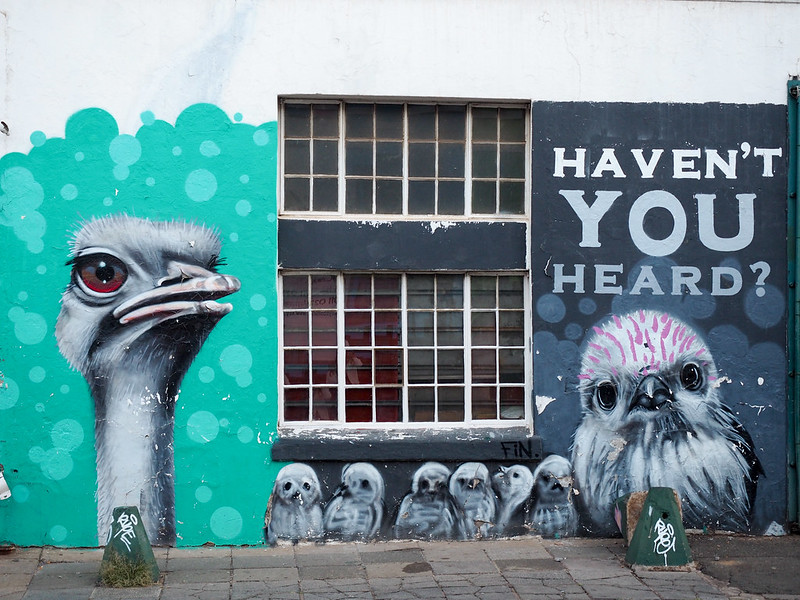
Where to stay in Johannesburg: The 54 on Bath is a great choice in Johannesburg. (Read reviews here.)
Where to eat in Johannesburg: Head to the bohemian Melville neighborhood for lots of great foodie finds. I ate at Lucky Bean, which serves up tasty South African dishes like springbok and ostrich.
Day 9: Cradle of Humankind
For your second day in Johannesburg, you actually might want to book a tour out to Maropeng and the Sterkfontein Caves, or “the Cradle of Humankind.” This UNESCO World Heritage Site is where some of the world's most significant hominid discoveries have been made.
Start out at the Maropeng visitor center, and then head to the caves for a guided tour. A visit to the caves is a bit adventurous (there's some crawling involved), but how often do you get the chance to visit the place where some of the earliest humans on earth lived?
Day 10: Kruger National Park
The absolute highlight of my time in South Africa was going on safari in Kruger National Park. So naturally I'm saving the best for last in this itinerary.
You can fly from Johannesburg to Skukuza on South African Airways, which will get you to Kruger with plenty of time to enjoy lunch and an afternoon game drive on your very first day.
There are tons of accommodation options to choose from in and around Kruger, and this is definitely a place where it's worth splurging on a really nice all-inclusive lodge.
I stayed at the Jock Safari Lodge, which is a private concession within Kruger that I did not ever want to leave. The villas all come with soaker tubs, outdoor day beds overlooking a dry riverbed, and even private plunge pools. And the staff and rangers here are all incredible.
READ MORE: The Private Game Lodge Experience in Kruger National Park

After arriving, we had some time to explore the property and then left on our first game drive in the late afternoon. And we saw the Big 5 (buffalo, elephant, rhino, lion, and leopard) all within this first safari!


Where to stay in Kruger: I was a huge fan of the Jock Safari Lodge, and would definitely recommend it. (Read reviews | Book here!)
Where to eat in Kruger: When you stay at an all-inclusive lodge, all of your meals will be included.
Day 11: Kruger National Park
You'll want to devote at least 2-3 nights to Kruger. Even though you might be thinking that one or two game drives will be enough, the truth is that you will never see the same thing twice on a game drive – meaning every single one is exciting and unique!
Along with the Big 5, we saw things like lions mating, baby elephants charging our truck, a momma and newborn white rhino, wild dogs facing off with hyenas, and much, much more.

Going on safari truly is a bucket-list-worthy activity, and even after 4+ game drives, I wasn't ready to leave!
Your days will look something like this:
- 5 a.m. wake-up
- 5:30 a.m. coffee/snacks
- 6-9 a.m. game drive (most animals are more active in the hours right around sunrise)
- 9:30 a.m. breakfast
- Relaxing time / maybe a walking safari offered
- Lunch
- More relaxing/pool time
- 4-7 p.m. evening game drive
- Dinner
- Bedtime!
RELATED: 8 Things to Know Before Your First African Safari
Day 12: Kruger + departure
You'll be able to squeeze in one more morning game drive on your last day, and then it will be time to fly back to Johannesburg and on to wherever in the world home is.
Extra time in South Africa?
If you have a couple extra days in South Africa to play with, you might want to consider adding one of the following to your itinerary:
The Blue Train
This luxury train, with its polished-wood interior and fancy lounge cars, is a throwback to the heyday of train travel. The Blue Train travels between Cape Town and Pretoria, taking 1.5 days to traverse essentially the length of South Africa.
This is definitely a luxury experience, but the weak South African rand actually makes it relatively affordable right now (well, relative to “normal” prices!).
I was lucky enough to ride the Blue Train on my trip, and I was impressed by the efficiency of the tiny rooms, the service, the food, and how lovely it was to just relax for a day and a half and watch the countryside slip by outside the window.
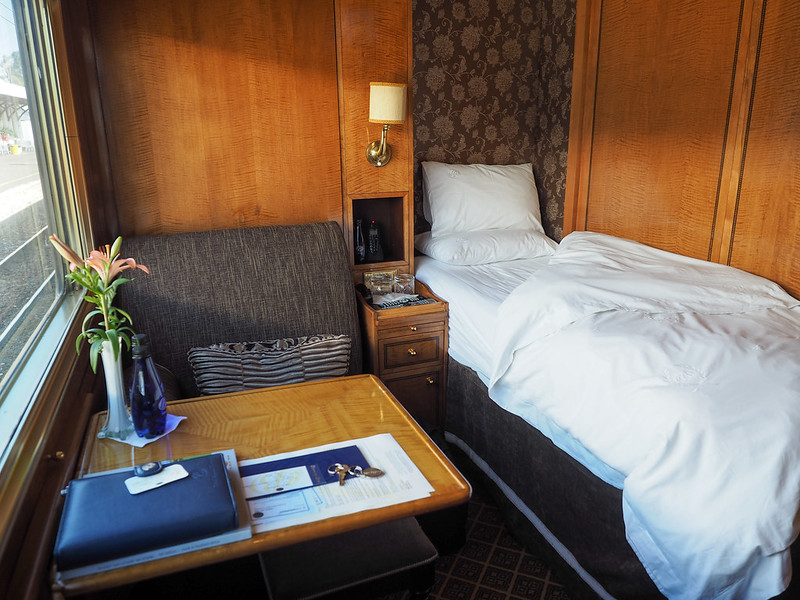
You can fit this in between Cape Town/Stellenbosch and your time in Johannesburg if you have an extra night to spend.
The Garden Route
If you have even MORE time and don't fancy an expensive train ride, consider driving the Garden Route along South Africa's southern coast. This is regarded as one of the most beautiful parts of South Africa, but does require at least a couple extra days to truly enjoy.
Where to next?
After exploring South Africa, why not head to the beach for a while? The Seychelles (a dreamy island nation in the Indian Ocean) is only a short flight away and pairs up great with South Africa.
Read more: How to Spend 1 Week in the Seychelles
This itinerary obviously doesn't encompass everything there is to see in South Africa – it largely skips the Garden Route, Durban, the Blyde River Canyon, and the Drakensberg mountains, for example. But in order to see it all, you'd need a lot more than just 12 days in South Africa!
This itinerary (in my opinion, at least), touches on the best parts of South Africa, mixing the natural and the urban into one unforgettable trip.
- Looking for packing suggestions for South Africa? Head over to my Africa packing list to see what my must-haves were.
- Pick up a South Africa travel guide before you go.
- Don't leave home without a good travel insurance plan – because you never know what might happen! I recommend World Nomads for affordable basic travel insurance.
Have you been to South Africa? If so, what are some of your favorite parts?

Amanda Williams is the award-winning blogger behind A Dangerous Business Travel Blog. She has traveled to more than 60 countries on 6 continents from her home base in Ohio, specializing in experiential and thoughtful travel through the US, Europe, and rest of the world. Amanda only shares tips based on her personal experiences and places she's actually traveled!







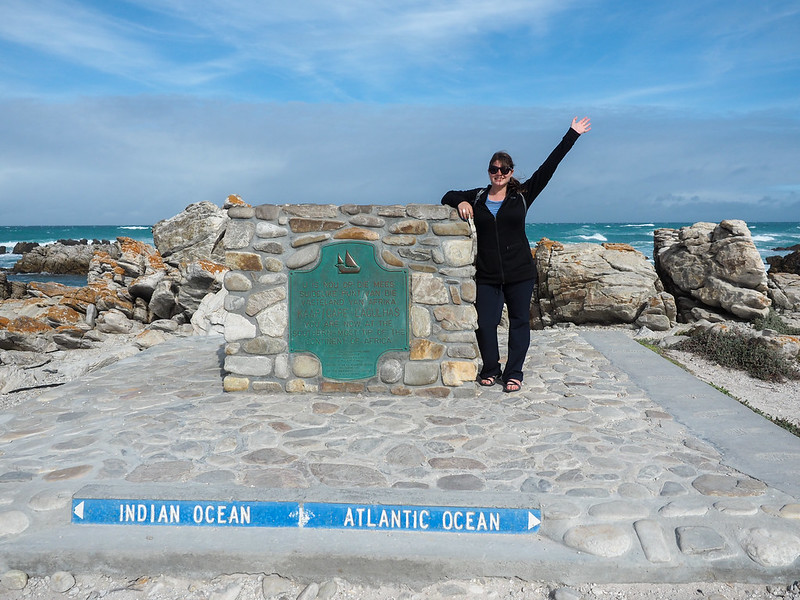











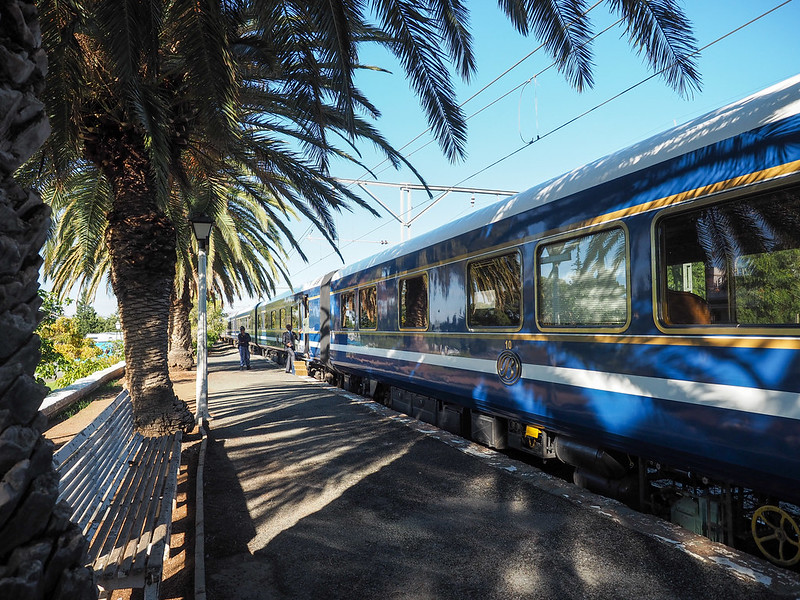
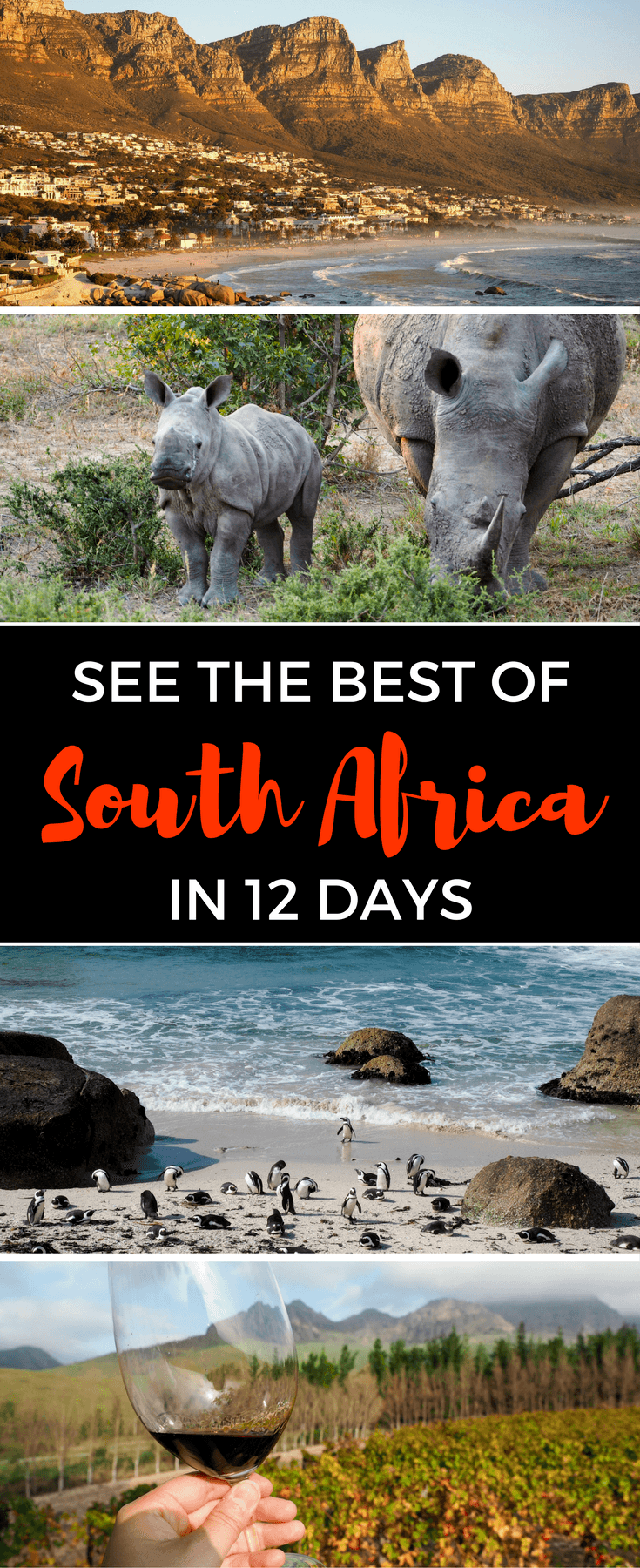
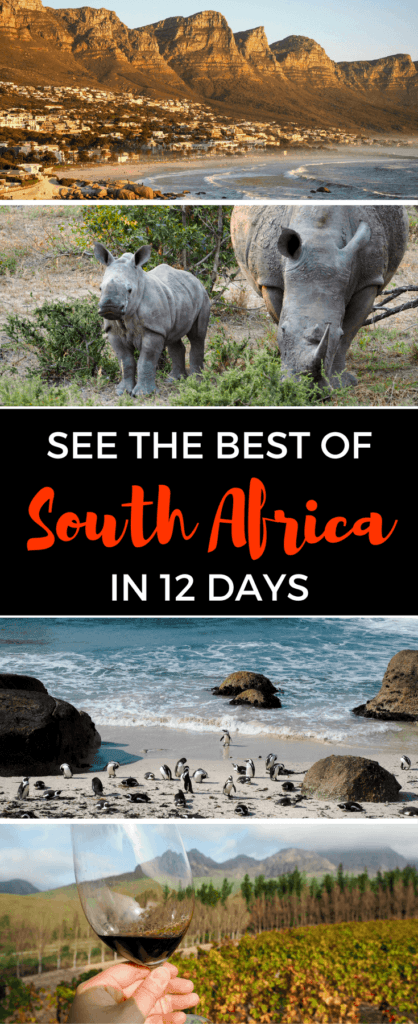









Hi Amanda,
Thank you for all the tips. South Africa has been my dream vacation. Reading your blogs and looking at your photos even excites me more. I am planning to bring along all my 5 kids there. Youngest is 9 years old. Whats your opinion abt bringing kids along and following your itinerary?
Hey Linda! Kids can definitely do most of the things on this itinerary! You might want to skip the wine tasting, and some of the museums/tours (like Robben Island and the Apartheid Museum) might be a bit heavy for kids – but you’d know better than me! Most of these things are actually pretty kid-friendly, though; Jock Safari Lodge even has a kid-friendly lodge called Fitzpatrick’s that’s great for families!
Hi,
I am a South African so I can give a little homegrown advice:
June to August is our low season as winter is a little cold, with temperatures are between -3 to 15 degrees Celsius. Winter is Johannesburg’s dry season and Cape Towns Wet Season. If Cape Towns sea is too cold for your liking another great location is the around the Durban coastline where the weather is warm most of the year. Do not stay in Durban city its awful and dirty, instead the neighboring towns around it are much nicer! (Richards bay, Umhlanga, Amazontoti, Margate and Balito) A hidden gem is St.Lucia, you can do whale watching, turtle tours, Hluhluwe / Nature Reserve is nearby, there are hippos walking the street and on the beach (they are aggressive and can kill you, so dont get too close!) Hope this helps 🙂
Thanks for the tips, Mary-Ann! All good info!
Thanks a lot! This is a great read.
I am leaving this comment here for those of you interested in visiting the northern part of South Africa. In the Limpopo province, there is a considerably new private game reserve called the Mapesu Private Game Reserve. It is spread across 7200ha and is definitely something that you cannot miss out on. The reserve houses a beautiful 4 star luxury lodge called Mopane Bush Lodge which is very affordable. The tour offered by the lodge is absolutely brilliant for the money that they charge their visitors.
I am presently planning a trip to Africa for July. I was wondering if I could do this on my own to make it a little less expensive. Your blog is amazing with all the links. You make me feel I could make this happen. Thank you for all your time and efforts.
Yes, you could definitely do this independently! You could also cut out some of the side trips (like Gansbaai and Stellenbosch) to save money, too. You could easily do a few days in Cape Town, fly to Johannesburg, and then do a Kruger safari. The only thing I would still recommend splurging on is the safari – staying a a good lodge will make the experience all the more memorable!
Mary Ann,
Thank you for the advice. I am looking forward to being in South Africa in July. This does help to have other ideas and options. I will look at some of these options since I will be there during the winter months….I am a summer person at heart so I may want to take your advice. Amanda….this is the best blog I have seen on traveling there. Thank you again!
Luckily “winter” in South Africa isn’t really the same as winter in many other parts of the world! I visited in May last year, and while I did usually wear jeans and a sweatshirt or light jacket, it was nothing compared to winter in Ohio!
That is good to know! That sounds doable for clothing!
Hey Amanda,
Really awesome post, I actually did the shark cage diving a month ago. Was so cool! Used to have a crippling fear of sharks. But realised they look more confused if anything lol.
I’m glad to hear you got over that fear! I think sharks are SO COOL.
I loved Africa! it is an amazing place!!!
look at this amazing trip to the panorama route : https://youtu.be/silpsES6Ddc
What would you recommend for getting around? Did you rent a car to get to Gansbaai or to get to Cape Agulhas? Thanks!
You *can* book tours/transport from Cape Town to Gansbaai. But if you then also wanted to go to Cape Agulhas, you’d need transport/a tour again. Renting a car would be ideal if possible, though the folks at The Roundhouse can help organize all of this, too, if you’d prefer not to drive yourself.
Any price estimate for a trip per person following this itinerary? Thanks!
It depends on a lot of factors, including the exchange rate when you’re going (I went when the rand was really weak, so was able to fit more in for less money!). My dad and I did a guided tour that included most of what’s mentioned here (including staying at the fanciest hotels, and a ride on the Blue Train) and it was about $3500 per person. You could easily lower that total if you stay in more budget-friendly hotels and skip the Blue Train.
Hi Amanda,
When is the best time to travel to South Africa? I’m thinking of visiting South Africa next year 🙂
I visited in May (basically like autumn) and really enjoyed it. But I honestly think South Africa is a year-round destination! I don’t know that there’s a “bad” time, especially since the country is quite big.
Just read the if there is a best time to visit commnet: In regards to animals is there a time of year where they are more abundant then other parts of the years, (Big 5, Penguins on the beach and sharks?)
Thanks.
You’ll always find penguins at Boulders Beach. As for sharks, the best times depend on where you want to see them. If you want to potentially see them hunting seals near Gansbaai, winter is the best time to go (they say April-late August, but I think June and July are really the best months!). And as for safari-type wildlife, the dry season (also winter) is often best because many animals are out and about searching for water. (Though I think wildlife sightings in Kruger are very good year-round, but winter is for sure the best time to see animals in other countries like Namibia and Botswana.)
Hello there, great post! May i know which camera did you use at the Safari? I have been using my iphone throughout my trips, and just not sure whether i should invest in sth for Africa.
You can read all about my photo gear here: https://www.dangerous-business.com/2017/02/travel-photography-gear/
Investing in a good camera was important for me and my blog – and if you love taking photos it may be something to consider!
South Africa is top on my list, the shark dive/whales, boulder beach, table mountain and Kruger are my top must see things. Any suggestions on prices, how long to visit and how to make it cheap but safe? Any other must see or do’s? Thanks for any advice!
Hey Kevin! All of my South Africa tips are right here in this post! I would recommend at least two weeks, but obviously the longer the better! And as for pricing… South Africa can definitely be a budget-friendly destination (especially with the strong dollar right now), but can also be luxurious. If you’re on a budget, I would look for hostels or cheaper hotels to stay in, maybe cut out the wine tasting, and rely on things like the hop-on, hop-off bus to see Cape Town. When it comes to a safari, though, I don’t recommend scrimping on that – if it’s a once-in-a-lifetime thing for you, it’s worth spending a few extra dollars!
Hi Amanda,
This seems like such an amazing trip! Thank you so much for all of your recommendations. My boyfriend and I are planning a very similar trip in 2018.
Thank you!
Erin
Happy to be able to help, Erin! South Africa is such a cool country. Hopefully I gave you a few new ideas in this post!
Wow! A 12 day trip! Will definitely love to try this!
I’d recommend even more days if you can, of course! There’s so much to see in South Africa.
You are very good at taking photos. These photos help the reader jumping into your journey. Make me feel as if I visited the same places. Great post!
Thanks very much! I’m not a professional photographer, but I do really love taking pictures!
Wow! I’m going to South Africa this July. I’ll most likely see Cape Town, Johannesburg, Tanzania, Botswana and Zimbabwe. This post has me even more excited, thank you!
Yay, glad I could help build that excitement!